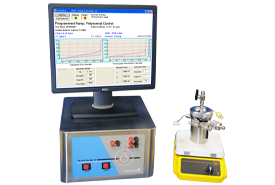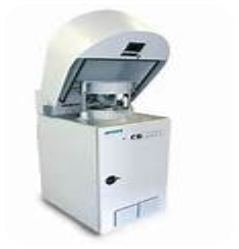Adiabatic calorimetry is a powerful tool that can be used to support plant safety. A calorimeter is a device that is used to measure the amount of heat associated with chemical or physical processes. An adiabatic calorimeter is designed to ensure that there is no heat transferred between the system and its surroundings. Therefore, an adiabatic calorimeter is designed so that the exothermic heat produced by a reaction directly goes to increasing the temperature. As the temperature increases, the rate of reactions often exponentially increases. On a large plant scale, the available cooling capacity is fixed, so as the rate of reaction exponentially increases, the heat generated from an exothermic reaction can surpass available cooling. This can lead to a runaway reaction. Some common scenarios that may lead to a runaway reaction include fire exposure, loss of cooling, overcharging or a reagent or catalyst, an all-in addition of a reagent, etc. Adiabatic calorimetry can be used to simulate these scenarios to characterize the potential for a runaway reaction and to collect the data necessary for emergency relief system (ERS) design using software such as FERST powered by CHEMCAD. Adiabatic calorimeters measure temperature and pressure increases associated with exothermic reactions, from which the adiabatic rates of temperature and pressure rise are developed.
VSP2 (VENT SIZING PACKAGE 2)
The VSP2 is a robust and customizable low thermal inertia adiabatic calorimeter capable of simulating a variety of abnormal process conditions.
 Test Cell Size: 116 mL
Test Cell Size: 116 mL- Containment Vessel Size: 4 L
- Typical Sample Size: 80 mL
- Typical Phi-Factor: Low; Approximately 1.09
- Typical Sensitivity: 0.05 to 0.1°C/min
- Typical Test Design (Open or Closed): Both available
- Thermocouple Measurement: Direct
- Stirring Capabilities: Strong with use of Super Stirrer
- Typical Modes of Operation: Heat-Wait-Search, Adiabatic Loss of Cooling, Imposed Background Heating
- Typical Setup Time: 1-4 Hours
- Material of Construction for Wetted Parts: Hastelloy C, Stainless Steel, or Glass
- Best Suited For: Simulating abnormal process conditions to collect directly scalable data suitable for vent sizing
ARSST (ADVANCED REACTIVE SYSTEM SCREENING TOOL)
The ARSST is an excellent screening tool with a small sample size that is easy and quick to operate and allows for a portable setup.
 Test Cell Size: 5-20 mL
Test Cell Size: 5-20 mL- Containment Vessel Size: 350 or 450 mL
- Typical Sample Size: 4-16 mL
- Typical Phi-Factor: Low; around 1.05
- Typical Sensitivity: 0.1°C/min
- Typical Test Design (open or closed): Open
- Thermocouple Measurement: Direct
- Stirring Capabilities: Good
- Typical Modes of Operation: Imposed Background Heating.
- Typical Setup Time: 1/2-1 Hour
- Material of Construction for Wetted Parts: Glass Test Cell, Variety of Thermocouple Material of Construction
- Best Suited For: Gas-generating systems, companies with limited sample quantities, and for quickly screening for adverse reactions
ARC (ACCELERATING RATE CALORIMETER)
The ARC is a sensitive instrument that is easy to operate.
 Test Cell Size: 10 mL
Test Cell Size: 10 mL- Containment Vessel Size: N/A
- Typical Sample Size: 0.5-10 grams
- Typical Phi-Factor: 1.5 and up
- Typical Sensitivity: 0.02°C/min
- Typical Test Orientation (open or closed): Closed
- Thermocouple Measurement: Indirect
- Stirring Capabilities: Poor or N/A
- Typical Modes of Operation: Heat-Wait-Search or Isothermal
- Typical Setup Time: 1/2-1 Hour
- Material of Construction for Wetted Parts: Hastelloy C, Stainless Steel, Titanium, or Tantalum
- Best Suited For: Identifying potential thermal hazards and early conversion kinetics.
Low-Thermal Inertia Calorimetry: Phi-Factor
The Phi-factor is a dimensionless parameter that is based on the ratio of the total heat capacity of the filled test cell (or vessel) and the total heat capacity of the sample (or vessel contents) alone. This ratio is an indication of how much heat is required to heat up the combined mass of the test cell (or vessel) and its contents relative to just heating the sample (or vessel contents). If the material is exothermically reacting, a heavy test cell will absorb some of this heat and therefore the full adiabatic potential will not be reached by the sample. In other words, in the field of adiabatic calorimetry we are not just cognizant of heat loss to the environment but also heat loss to the container (i.e. test cell). This parameter serves as a correction factor that can be used to adjust collected adiabatic data. For large vessels, light vessels, or at true adiabatic conditions, the Phi – factor approaches 1. Therefore, a Phi – factor of 1.1 indicates that the temperature rise data collected in an adiabatic instrument may need to be adjusted by approximately 10% (for example, to estimate the adiabatic temperature rise). Note that the effect on kinetics (for example, reaction rates) is nonlinear. As you increase the Phi – factor, the required correction to the data increases. With too large of a Phi – factor, a concern is that you may be missing additional thermal potential (e.g. secondary decomposition reactions which can occur at higher temperatures). Having a low Phi – factor adiabatic calorimetry like the ARSST and VSP2 is ideal for directly scaling the collected data to full scale vessels.
For more information, or guidance into what test method is right for you, contact Elizabeth Raines at eraines@fauske.com.
